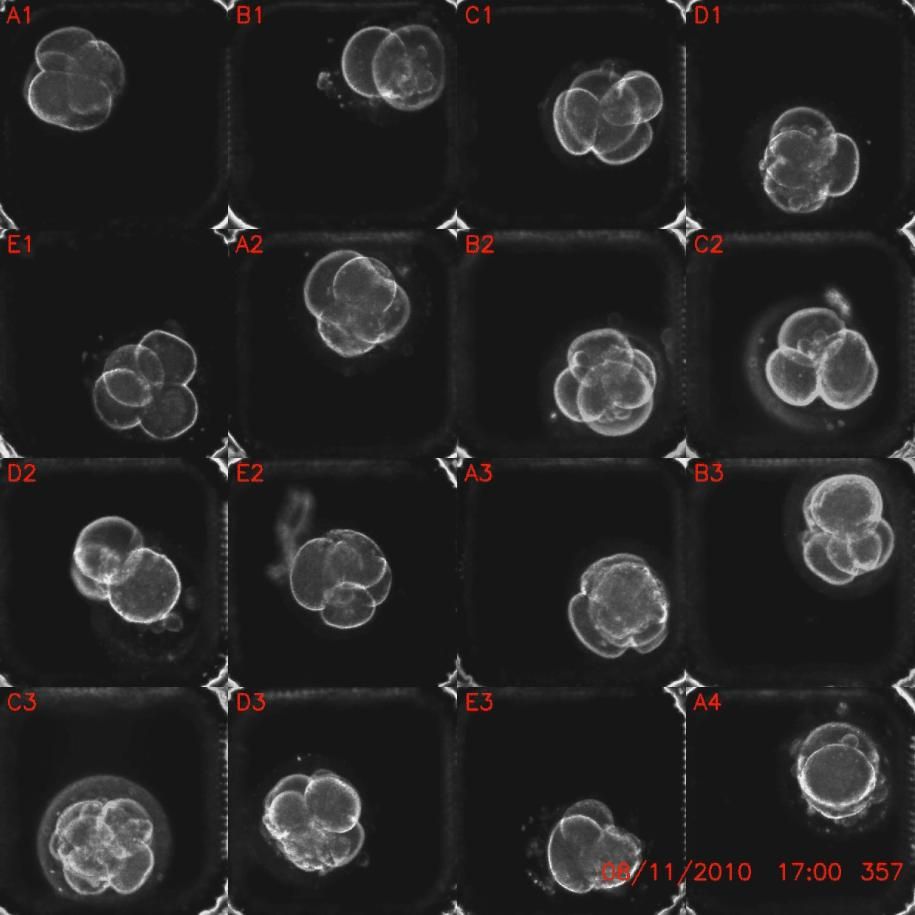Early Embryo's Odd Behavior Reveals Chances of Miscarriage

Amazing time-lapse videos of embryos in the very earliest stages of development could help fertility doctors prevent miscarriage, new research suggests.
By watching the timing of the cells' development, doctors could determine which cells are genetically healthy, and which have abnormal numbers of chromosomes, finds the study published today (Dec. 4) in the journal Nature Communications.
"What we've shown is that by watching, you can detect some differences in the movements in the cell cycle of those [embryos] that are carrying errors from those that are more likely to survive," said study researcher Renee Reijo Pera, who studies stem cells and early embryo development at Stanford University.
Chromosomes are coiled packets of DNA. Humans have 23 pairs of chromosomes, but genetic accidents can alter that number, a condition called aneuploidy. Some aneuploidies cause disorders such as Down syndrome, which occurs when there are three chromosomes on what should be the 21st pair. Other aneuploidies are incompatible with life, causing early miscarriage or later stillbirth.
Extra or missing chromosomes are shockingly common, affecting up to 75 percent of all embryos, studies find. This may be why as many as 50 to 75 percent of pregnancies are so-called "chemical pregnancies," meaning that an embryo spontaneously aborts right after implantation in the uterus. Many women with chemical pregnancies may not even realize they were ever pregnant.
There's little to be done about these early miscarriages in typical pregnancies. For in vitro fertilization (IVF), however, it's important to choose embryos with the best chance of life to prevent miscarrying.
Pera and her colleagues have already found that abnormal embryos show strange behaviors in the first four days of development. For example, the length of time it takes an abnormal embryo to complete its very first division from one cell body to two differs from the time it takes for a normal embryo to do the same.
Sign up for the Live Science daily newsletter now
Get the world’s most fascinating discoveries delivered straight to your inbox.
Abnormal embryos also show more fragmentation, Pera told LiveScience. Fragmentation occurs when one cell in an embryo experiences a problem. In most situations, a cell with a problem simply dies. In embryos, however, these cells seem to break apart instead. Often, DNA-containing cell fragments will fuse with other cells in the embryo, transferring extra chromosomes to those cells.
The researchers wanted to know whether they could use these odd behaviors to reliably distinguish a healthy embryo from a doomed one. They took 75 human embryos that had been frozen at the single-cell phase and cultured them in Petri dishes for two days, taking a microscopic snapshot of each embryo every five minutes. [See Video of the Developing Embryos]
These snapshots were then strung together into time-lapse movies, which the researchers analyzed for the timing of various cell-division phases.
Of the 75 original cells, 53 survived four days, which represents the zygote stage of embryonic development. Of those, 45 were usable for genetic analysis. About 75 percent, or 34 of the 45 cells surviving to the zygote stage, had the wrong number of chromosomes.
The abnormal cells showed more variations in their cell-division cycles than normal cells, the researchers found. While normal cells all developed at similar paces, abnormal cells lagged behind or sped ahead in the divisions of the first, second and third cells.
Combining data about the abnormal timing with other signs that something has gone wrong (such as fragmented DNA and asymmetrical cell sizes within a developing embryo) could reliably show which cells have the right number of chromosomes and which don't, the researchers report.
The findings offer some insight into why early human development is so likely to go wrong, Pera said. Other animals don't have so many problems, she said. Mice, for example, make mistakes in embryo development only about 1 percent of the time.
Researchers have long thought that perhaps humans have so many problems because women's eggs degrade with age, Pera said. But in the current study, only 20 percent of the embryos showed these kind of errors. Much more frequent were so-called mitotic errors, which occur later in development, after sperm and cell fuse and the embryo begins to divide.
"That so many errors are being made after the egg and the sperm come together, that appears to be kind of special to humans," Pera said.
A California-based biotech company has now licensed the embryo-watching technology and is going to begin testing it in fertility clinics, Pera said. The hope is that doctors can use the technique as a way to non-invasively watch embryos before implanting them in women, ensuring that they pick the cell clusters most likely to survive to birth.
Editor's Note: This article was updated at 4pm EST to add comments from the researcher.
Follow Stephanie Pappas on Twitter @sipappas or LiveScience @livescience. We're also on Facebook & Google+.

Stephanie Pappas is a contributing writer for Live Science, covering topics ranging from geoscience to archaeology to the human brain and behavior. She was previously a senior writer for Live Science but is now a freelancer based in Denver, Colorado, and regularly contributes to Scientific American and The Monitor, the monthly magazine of the American Psychological Association. Stephanie received a bachelor's degree in psychology from the University of South Carolina and a graduate certificate in science communication from the University of California, Santa Cruz.

'Love hormone' oxytocin can pause pregnancy, animal study finds

'Mini placentas' in a dish reveal key gene for pregnancy










